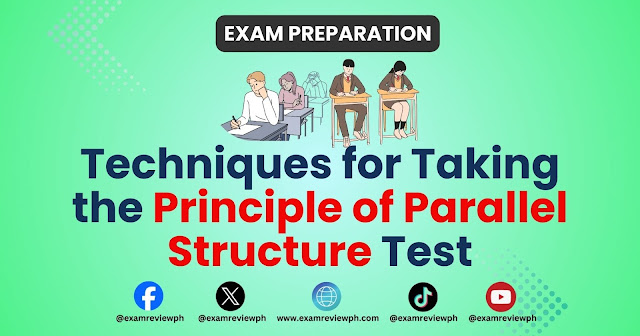The Principle of Parallel Structure, also known as parallelism, is a grammatical principle that requires consistency in the structure of phrases, clauses, or sentences. Parallel structure ensures that similar ideas are expressed in a balanced and grammatically correct manner, enhancing clarity and readability. This principle typically applies to lists, comparisons, and paired elements within sentences. Elements in parallel structures should follow the same grammatical pattern, such as using the same verb tense, form, or structure. Examples include "She likes to hike, swim, and bike" (parallel verbs in the same form) and "He is not only a talented writer but also an accomplished painter" (parallel phrases joined by "not only...but also").
More Examples of the Principle of Parallel Structure
Incorrect: The teacher said we should read the book, write a summary, and preparing a presentation.
Explanation: The correct sentence uses parallel infinitive phrases (read the book, write a summary, prepare a presentation). The incorrect sentence uses a gerund (preparing a presentation) instead of an infinitive, disrupting parallelism.
Correct: She wants to travel to Japan, to explore Europe, and to visit Australia.
Incorrect: She wants to travel to Japan, to explore Europe, and visiting Australia.
Explanation: The correct sentence maintains parallel infinitive phrases (to travel, to explore, to visit). The incorrect sentence mixes an infinitive (to travel) with a gerund (visiting), breaking parallel structure.
Correct: They are not only kind but also generous.
Incorrect: They are not only kind but also generosity.
Explanation: The correct sentence uses adjectives (kind, generous) in parallel form. The incorrect sentence mixes an adjective (kind) with a noun (generosity), disrupting parallelism.
Correct: He is talented in singing, dancing, and acting.
Incorrect: He is talented in singing, dancing, and to act.
Explanation: The correct sentence uses gerunds (singing, dancing, acting) in parallel structure. The incorrect sentence introduces an infinitive (to act), breaking parallelism.
Incorrect: The manager is responsible for hiring employees, training new staff, and to conduct evaluations.
Explanation: The correct sentence uses gerunds (hiring, training, conducting) in parallel form. The incorrect sentence mixes gerunds with an infinitive (to conduct), disrupting parallel structure.
Incorrect: I will either go to the gym or running.
Explanation: The correct sentence maintains parallel infinitive phrases (go to the gym, go for a run). The incorrect sentence introduces a gerund (running), breaking parallel structure.
Incorrect: The project involves researching, planning, and to implement new strategies.
Explanation: The correct sentence uses gerunds (researching, planning, implementing) in parallel form. The incorrect sentence introduces an infinitive (to implement), disrupting parallelism.
Technique for Taking a Principle of Parallel Structure Test
1. Identify Parallel Elements:
- Recognize phrases, clauses, or lists that contain elements to be compared or contrasted.
2. Analyze Grammatical Patterns:
- Determine the grammatical pattern (e.g., verb tense, form) used in the parallel elements.
3. Ensure Consistency:
- Make sure that all elements in the parallel structure follow the same grammatical pattern.
4. Check for Balanced Structure:
- Ensure that the parallel elements are balanced in terms of meaning and structure.
5. Revise Non-Parallel Structures:
- Rewrite sentences or phrases to ensure parallelism if any inconsistencies are found.
6. Be Mindful of Connectors:
- Pay attention to coordinating conjunctions (e.g., "and," "but," "or") used to join parallel elements.
7. Practice with Examples:
- Engage in exercises that focus on identifying and correcting parallel structure errors.
- Review examples of well-constructed parallel structures to reinforce understanding.
By applying these techniques, you can effectively tackle Principle of Parallel Structure tests and improve your writing clarity and coherence.

